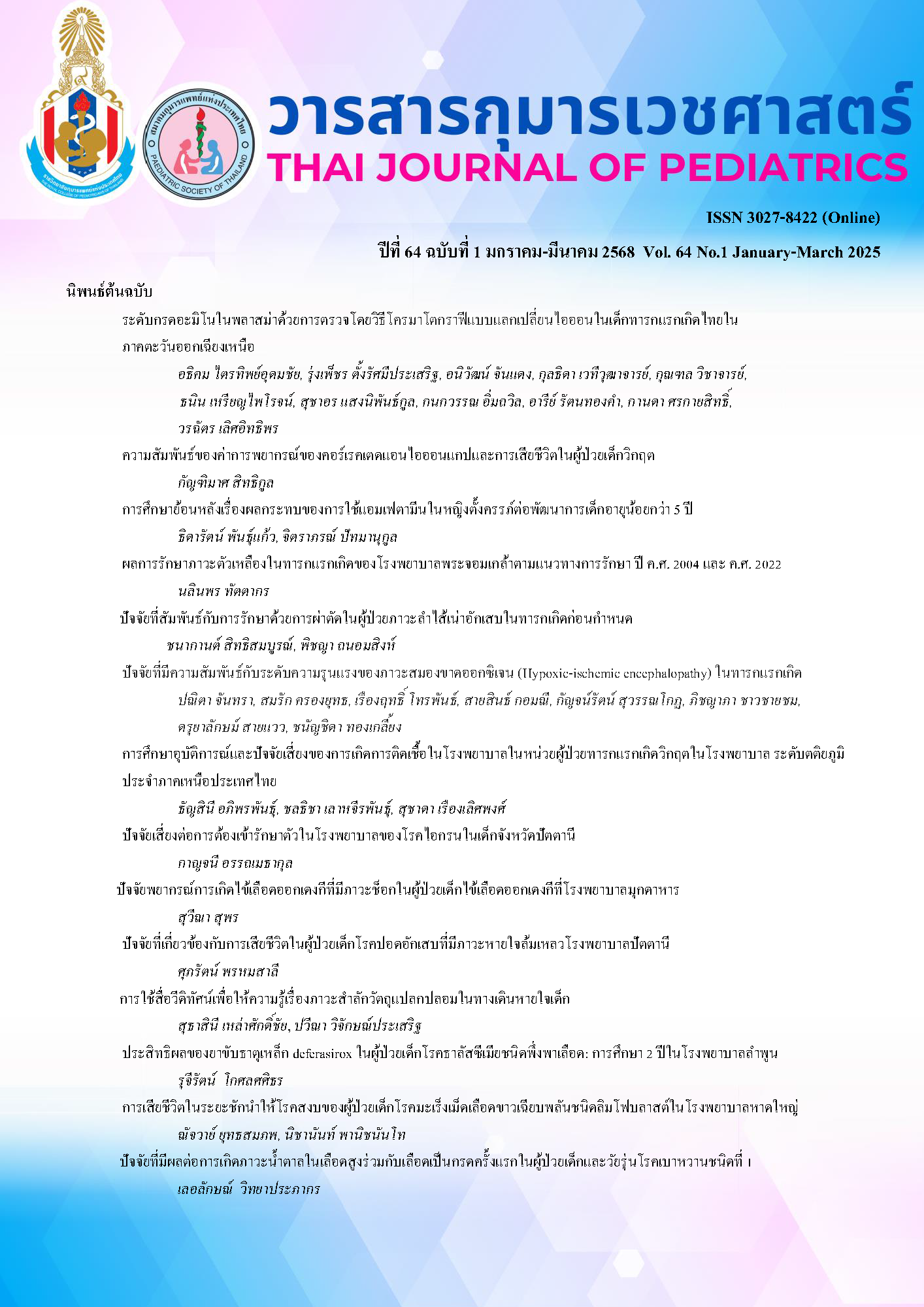Mortality in pediatric acute lymphoblastic leukemia in induction phase of chemotherapy at Hatyai Hospital
Keywords:
Acute lymphoblastic leukemia, mortality rate, induction phase, risk factors of recurrent seizures within 24 hoursAbstract
Background: Acute lymphoblastic leukemia is the most common cancer in children, accounting for 40 percent of Thai pediatric cancers. The overall 5-year survival rate has risen due to the use of intensive chemotherapy. The mortality rate is highest during the induction phase of chemotherapy.
Objective: To study the mortality rate and factors influencing mortality in induction phase of chemotherapy pediatric acute lymphoblastic leukemia patients at Hatyai Hospital.
Method: We performed a retrospective study, collecting data from the Hatyai Hospital database between August 2011 to April 2021. Patients aged under 15 years old who were newly diagnosed with acute lymphoblastic leukemia and treated with the Thai-POG chemotherapy protocols at Hatyai Hospital were included. The mortality rate, cause of death, and the factors associated with mortality during induction phase of chemotherapy were analyzed.
Results: A total of 197 patients were included in this study and 55% of them were male. The most common age range was 4-10 years old (43.7%).Common presentations were fever (79.2%), hepatomegaly (74.6%), lymphadenopathy (62.4%), splenomegaly (59.4%), and anemia (25.9%), respectively. The induction phase mortality rate was 14.7%, and infection was the most common cause of death (79.3%). Risk factors found to increase mortality during the induction phase included thrombocytopenia ≤ 20,000/cu.mm. increased risk by 3.65 times compared with patient platelet >20,000 (95% CI 1.15-11.60, p value 0.028), Invasive aspergillosis infection increased risk by 64.1 times compared with patients without invasive aspergillosis (95% CI 6.24-657.96, p value 0.001). Sepsis increased risk by 32.0 times compared with patient without sepsis (95% CI 7.77-132.17, p value 0.001)
Conclusion: The induction phase mortality rate was 14.7%, and the major cause of death was infection. Thrombocytopenia ≤ 20,000/cu.mm., invasive aspergillosis infection, and sepsis increased the risk of mortality in induction phase of chemotherapy in pediatric acute lymphoblastic leukemia patients at Hatyai Hospital.
Downloads
References
วนิดา พงศ์สถาพร. มะเร็งเม็ดเลือดขาวแบบเฉียบพลันชนิดลิมฟอยด์ในเด็ก. วารสารโรคมะเร็ง. 2559;36:68-75.
Wiangnon S, Veerakul G, Nuchprayoon I, Seksarn P, Hongeng S, Krutvecho T, et al. Childhood cancer incidence and survival 2003-2005, Thailand: Study from the Thai Pediatric Oncology Group. Asian Pac J Cancer Prev. 2011;12: 2215-20.
Silverman L. Acute Lymphoblastic Leukemia. In: Orkin S, Fisher D, Look A, Lux S, Ginsburg D, Nathan D. Oncology of Infancy and Childhood. 1st edition. Philadelphia: Saunders Elsevier; 2009: 297-330.
Hao T, Hiep P, Hao N, Ha C. Causes of death in childhood acute lymphoblastic leukemia at Hue central hospital for 10 years (2008-2018). Glob Pediatr Health. 2020;7:1-8.
Seif A, Fisher B, Li Y, Torp K, Rheam D, Huang Y, et al. Patient and hospital factors associated with induction mortality in acute lymphoblastic leukemia, Pediatr Blood Cancer. 2014;61:846-52.
Nakagawa S, Kato M, Imamura T, Imai C, Koh K, Kawano Y, et al, In-hospital management might reduce induction deaths in pediatric patients with acute lymphoblastic leukemia: Results from a Japanese cohort. J Pediatr Hematol Oncol. 2021;43:39-46.
Khan MI, Naseem L, Manzoor R, Yasmeen N. Mortality analysis in children during induction therapy for acute lymphoblastic leukemia. JIMDC. 2017;6:69-72.
Raetz E, Teachey D. T-cell acute lymphoblastic leukemia. Hematology Am Soc Hematol Educ Program. 2016;2016:580–8.
ปิยะ รุจกิจยานนท์. มะเร็งเม็ดเลือดขาวชนิดเฉียบพลันในเด็ก (Childhood Acute Leukemia), [อินเตอร์เน็ต]. สมาคมโลหิตวิทยาแห่งประเทศไทย. [เข้าถึงเมื่อ 15 มกราคม 2565]. เข้าถึงได้จาก: http://tsh.or.th/Knowledge/Details/46
Inaba H, Pei D, Wolf J, Howard SC, Hayden RT, Go M, et.al. Infection-related complications during treatment for childhood acute lymphoblastic leukemia. Ann Oncol. 2017;28:386-92.
Afzal S, Ethier MC, Dupuis LL, Tang L, Punnett AS, Richardson SE, et al. Risk factors for infection-related outcomes during induction therapy for childhood acute lymphoblastic leukemia. Pediatr Infect Dis J. 2009;28:1064-8.
O’Connor D, Bate J, Wade R, Clack R, Dhir S, Hough R, et al. Infection-related mortality in children with acute lymphoblastic leukemia: An analysis of infectious deaths on UKALL2003. Blood. 2014;124:1056-61.
Seif A, Rheingold A, Fisher B, Huang YS, Li Y, Kersun L, et al. Induction mortality in pediatric acute lymphoblastic leukemia (ALL): A retrospective cohort analysis from the pediatric health systems information (PHIS) database. Blood. 2010;116:3239.
Kong SG, Seo JH, Jun SE, Lee BK, Lim YT. Childhood acute lymphoblastic leukemia with hyperleukocytosis at presentation. Blood Res. 2014;49:29-35.
Hassan AM, Sadek A, Hassan ES, Abbas AA. Tumor lysis syndrome in children with acute leukemia: Incidence and outcome. JAppl Hematol. 2013;4:100-3.
Anugulruengkitt S, Trinavarat P, Chantranuwat P, Sritippayawan S, Pancharoen C, Thanyawee P. Clinical features and survival outcomes of invasive aspergillosis in pediatric patients at a medical school in Thailand. J Med Assoc Thai. 2016;99:150-158.
Abbasi S, Shenep J, Hughes W, Flynn P. Aspergillosis in children with cancer: A 34-year experience. Clin Infect Dis. 1999;29:1210–1219.
Downloads
Published
How to Cite
Issue
Section
License
Copyright (c) 2025 The Royal College of Pediatricians Of Thailand

This work is licensed under a Creative Commons Attribution-NonCommercial-NoDerivatives 4.0 International License.


